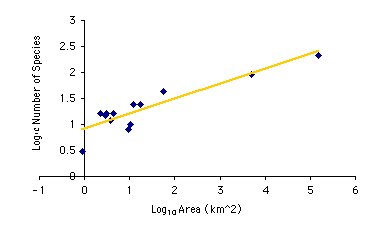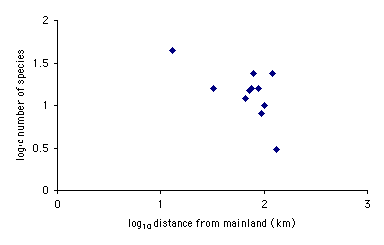
Introduction: The relationship between island area and number of species is well known: larger islands contain more species than smaller islands. "Islands" can be used to refer not only to pieces of land surrounded by water, but to habitat islands as well (lakes, forest fragments, etc.). Although the relationship is clearly demonstrated by many taxa, the causes of the relationship are less clear. This is possibly the most general pattern found in ecology, and many explanations have been proposed.
Importance: Spatial diversity patterns have important implications for conservation of biodiversity, and understanding these patterns contributes to our knowledge of community structure.
Question: What factor(s) may account for the species-area relationship? What other factors may come into play in determining the number of species on an island?
Variables:
| S | number of species |
| C | fitted constant |
| A | area of the island |
| z | fitted constant |
Methods: MacArthur and Wilson proposed the "equilibrium model of island biogeography" in the 1960ís. The basic idea of the model is that the number of species on an island is determined by the immigration of new species and the extinction of species already present; when these two rates balance one another, the species number is at equilibrium. An important assumption of the model is that the population sizes for each species are proportional to island size. All other things being equal (habitat diversity and distance to the mainland or source of colonizing species), if we have two islands with the same immigration rates, we would expect extinction rates on large islands to be lower because of their larger population sizes. Therefore larger islands, at equilibrium, would have a greater number of species. On the other hand, if we have two islands equal in size and habitat diversity but at different distances from the source, then extinction rates would be expected to be the same, but immigration rates would be higher for the nearer island, and at equilibrium the near island would have more species.
The species-area relationship can be approximated by a power function of the form:
S = CAz
which is often presented in linear form: log10S = log10 C + z log10 A. The constants C and z are fitted from the data on island area and number of species, and so are specific to a data set.
Browne and Peck (1996) used long-horned beetles (Cerambycidae: Coleoptera) to investigate the species-area relationship in the Florida Keys and mainland. Their data are plotted below, using the log10 of the area and species number. The two data points furthest to the right represent, from left to right, South Florida (the area south of Lake Okeechobee) and the entire state of Florida. All other data points are from the Keys.

We can also plot the log10 of species number against the log10 of the distance of the islands from the Florida mainland.

Interpretation: The relationship between the log10 of the species number and the log10 of island area clearly shows an increasing trend, and is well-approximated by the linear form of the model. Similarly, a decreasing trend of species number with island
distance can be seen from the second graph. Whether or not the number of species is at equilibrium is less clear; interpretation of the data regarding this question is made more difficult by uncertainty about the history of sea-level changes over the past 10,000 years.
Conclusions: Both island size and distance from the mainland are associated with the number of species present. In general, it has been found that the relationship between island area and number of species present is fairly constant for islands in a given geographic region. In this way it is possible to make potentially useful predictions about the number of species on islands (or habitat islands) when little information other than size is available. For conservation planning, knowledge of this relationship is of utmost importance.
Additional Question:
1. Estimate the equation for a line fitting the data in the graph of log10 species number by log10 distance.
Sources: Browne, J. B. and S. B. Peck. 1996. The long-horned beetles of south Florida (Cerambycidae: Coleoptera): biogeography and relationships with the Bahama Islands and Cuba. Canadian Journal of Zoology 74:2154-2169.
Gotelli, N. J. 1998. A Primer of Ecology, 2nd edition. Sinauer Associates, Inc., Sunderland, MA.
MacArthur, R. H. and E. O. Wilson. 1967. The Theory of Island Biogeography. Princeton University Press, Princeton, NJ.
copyright 1999 M. Beals, L. Gross, S. Harrell